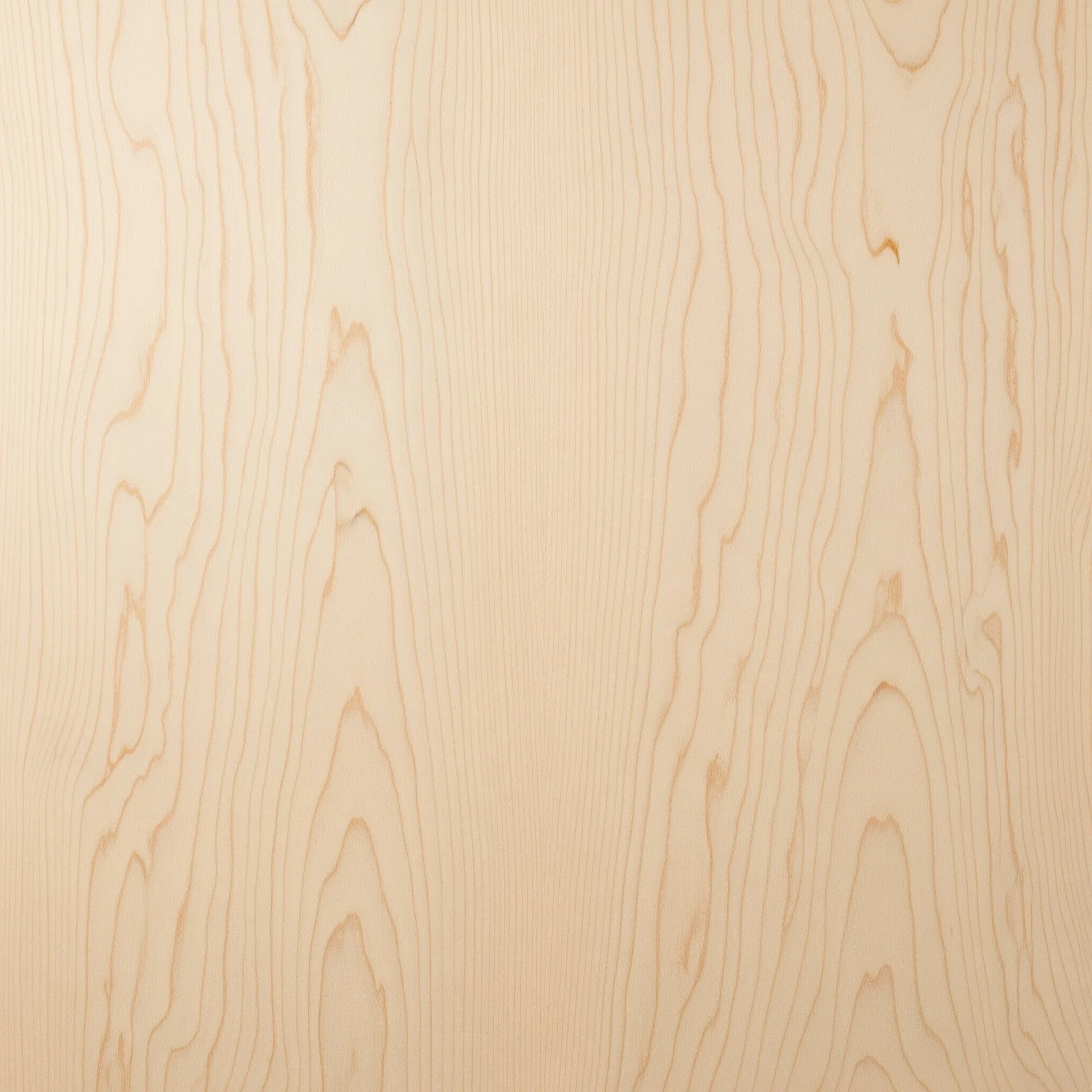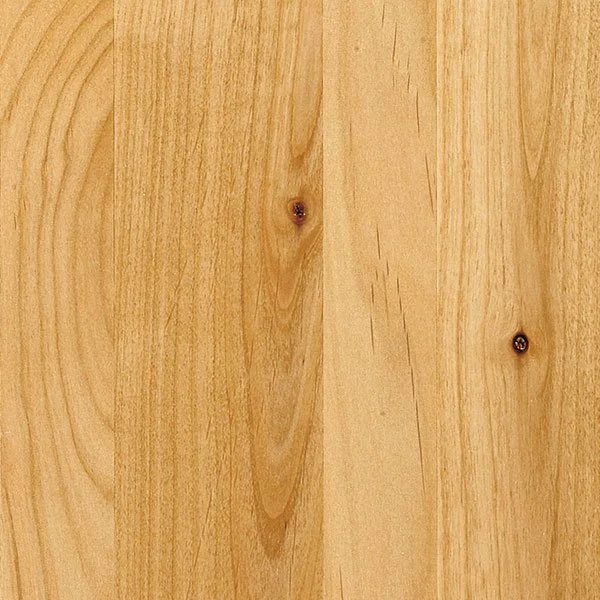Wood Species
Maple
Maple, a highly versatile and popular choice in cabinetry, offers a spectrum of characteristics that make it suitable for diverse design aesthetics and functional demands. Broadly categorized into Hard Maple and Soft Maple, both share the wood's signature subtle grain, but with distinct differences.
Hard Maple, also known as Sugar Maple or Rock Maple, is renowned for its exceptional density and strength, making it one of the hardest domestic hardwoods available. Its tight, uniform grain is relatively inconspicuous, providing a clean, consistent canvas. This characteristic makes it an outstanding choice for painted finishes, where it delivers a wonderfully smooth, flawless surface free from discernible grain patterns bleeding through. While it can be stained, its dense nature means it absorbs stain less evenly than other woods, often resulting in a somewhat blotchy appearance if not properly conditioned. For this reason, it excels when a consistent, opaque finish is desired.
Soft Maple encompasses several species, including Red Maple and Silver Maple. Though "soft" relative to Hard Maple, it is still a durable wood, comparable to cherry. Its grain is typically more pronounced than Hard Maple's but still relatively fine. Soft Maple generally takes stains more readily and evenly than Hard Maple, allowing for a wider range of stained finishes that enhance its natural patterns. It also paints beautifully, though its slightly more open grain might offer a subtler texture beneath the paint compared to Hard Maple.
In terms of durability, both types of maple offer excellent resistance to dents and wear, particularly Hard Maple, making them highly resilient choices for busy environments like kitchens. Their inherent stability and strength contribute to cabinetry that stands up well to daily use and maintains its integrity for many years. Whether you seek the pristine uniformity for a painted finish or a more varied stained appearance, maple provides a robust and elegant foundation for your cabinetry.
Alder
Alder is a beautiful and versatile hardwood, highly prized for its consistent grain and adaptable nature, making it an excellent choice for cabinetry that offers both elegance and value. Naturally, Alder presents a soft, reddish-brown hue with a fairly straight and even grain, often featuring small, dispersed pin knots that add character.
Its balanced density and fine, uniform pore structure allow Alder to excel in both stained and painted applications. It absorbs stains remarkably well and evenly, making it an ideal canvas for achieving a wide range of rich, consistent colors that beautifully enhance its natural grain. This superior stainability allows it to mimic more expensive woods like cherry or mahogany, providing a luxurious look at a more accessible price point. For painted finishes, Alder's smooth surface and minimal grain ensure a flawless, uniform coat, resulting in a refined and contemporary appearance.
In terms of durability, Alder is considered a "medium-density" hardwood, softer than maple but more resilient than pine. It offers good resistance to denting and marring under normal use, contributing to cabinetry that is both sturdy and long-lasting.
A popular variation is Rustic Alder, which intentionally embraces the wood's natural imperfections. This grade includes more frequent and larger knots, mineral streaks, and other natural characteristics that are left unfilled, providing a charming, antique, or distressed aesthetic. Rustic Alder is particularly favored for designs seeking a warm, inviting, and authentic farmhouse, lodge, or traditional look, where its inherent "flaws" become unique features that tell a story and add unparalleled character to the cabinetry. Whether you seek pristine uniformity or rustic charm, Alder offers a beautiful and adaptable foundation.
Cherry
Maple, a highly versatile and popular choice in cabinetry, offers a spectrum of characteristics that make it suitable for diverse design aesthetics and functional demands. Broadly categorized into Hard Maple and Soft Maple, both share the wood's signature subtle grain, but with distinct differences.
Hard Maple, also known as Sugar Maple or Rock Maple, is renowned for its exceptional density and strength, making it one of the hardest domestic hardwoods available. Its tight, uniform grain is relatively inconspicuous, providing a clean, consistent canvas. This characteristic makes it an outstanding choice for painted finishes, where it delivers a wonderfully smooth, flawless surface free from discernible grain patterns bleeding through. While it can be stained, its dense nature means it absorbs stain less evenly than other woods, often resulting in a somewhat blotchy appearance if not properly conditioned. For this reason, it excels when a consistent, opaque finish is desired.
Soft Maple encompasses several species, including Red Maple and Silver Maple. Though "soft" relative to Hard Maple, it is still a durable wood, comparable to cherry. Its grain is typically more pronounced than Hard Maple's but still relatively fine. Soft Maple generally takes stains more readily and evenly than Hard Maple, allowing for a wider range of stained finishes that enhance its natural patterns. It also paints beautifully, though its slightly more open grain might offer a subtler texture beneath the paint compared to Hard Maple.
In terms of durability, both types of maple offer excellent resistance to dents and wear, particularly Hard Maple, making them highly resilient choices for busy environments like kitchens. Their inherent stability and strength contribute to cabinetry that stands up well to daily use and maintains its integrity for many years. Whether you seek the pristine uniformity for a painted finish or a more varied stained appearance, maple provides a robust and elegant foundation for your cabinetry.
Alder
Alder is a beautiful and versatile hardwood, highly prized for its consistent grain and adaptable nature, making it an excellent choice for cabinetry that offers both elegance and value. Naturally, Alder presents a soft, reddish-brown hue with a fairly straight and even grain, often featuring small, dispersed pin knots that add character.
Its balanced density and fine, uniform pore structure allow Alder to excel in both stained and painted applications. It absorbs stains remarkably well and evenly, making it an ideal canvas for achieving a wide range of rich, consistent colors that beautifully enhance its natural grain. This superior stainability allows it to mimic more expensive woods like cherry or mahogany, providing a luxurious look at a more accessible price point. For painted finishes, Alder's smooth surface and minimal grain ensure a flawless, uniform coat, resulting in a refined and contemporary appearance.
In terms of durability, Alder is considered a "medium-density" hardwood, softer than maple but more resilient than pine. It offers good resistance to denting and marring under normal use, contributing to cabinetry that is both sturdy and long-lasting.
A popular variation is Rustic Alder, which intentionally embraces the wood's natural imperfections. This grade includes more frequent and larger knots, mineral streaks, and other natural characteristics that are left unfilled, providing a charming, antique, or distressed aesthetic. Rustic Alder is particularly favored for designs seeking a warm, inviting, and authentic farmhouse, lodge, or traditional look, where its inherent "flaws" become unique features that tell a story and add unparalleled character to the cabinetry. Whether you seek pristine uniformity or rustic charm, Alder offers a beautiful and adaptable foundation.


